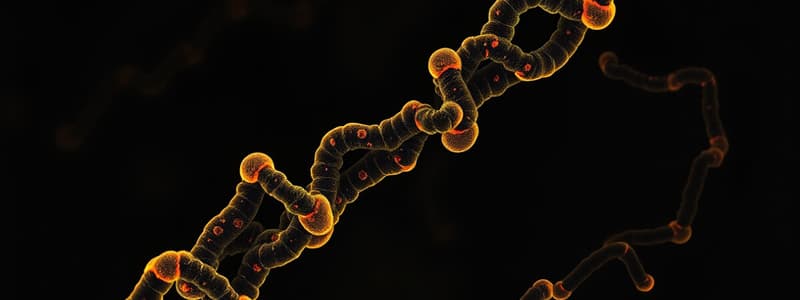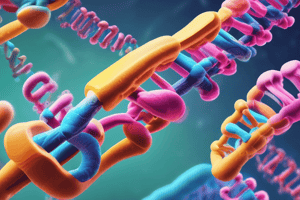Podcast
Questions and Answers
What are the two main types of chromatin?
What are the two main types of chromatin?
- Active and Inactive
- Dense and Sparse
- Heterochromatin and Euchromatin
- Constitutive and Facultative (correct)
What is the appearance of heterochromatin under a microscope?
What is the appearance of heterochromatin under a microscope?
- Darkly stained (correct)
- Transparent
- Fluorescent
- Lightly stained
Which of the following statements about euchromatin is true?
Which of the following statements about euchromatin is true?
- It is always tightly packed.
- It helps maintain chromosome structure.
- It is actively transcribed. (correct)
- It is gene-poor.
Which region of a chromosome is typically associated with constitutive heterochromatin?
Which region of a chromosome is typically associated with constitutive heterochromatin?
What characteristic distinguishes facultative heterochromatin from constitutive heterochromatin?
What characteristic distinguishes facultative heterochromatin from constitutive heterochromatin?
What happens to the genes in heterochromatin?
What happens to the genes in heterochromatin?
What is the primary role of constitutive heterochromatin in the cell?
What is the primary role of constitutive heterochromatin in the cell?
Which type of chromatin is primarily found in gene-rich regions?
Which type of chromatin is primarily found in gene-rich regions?
What is a key difference between meiosis I and meiosis II during prophase?
What is a key difference between meiosis I and meiosis II during prophase?
Which type of cell division do skin cells undergo to repair wounds?
Which type of cell division do skin cells undergo to repair wounds?
Which of the following occurs at the end of meiosis II?
Which of the following occurs at the end of meiosis II?
What is the main purpose of meiosis in cells?
What is the main purpose of meiosis in cells?
During which stage do sister chromatids separate in meiosis II?
During which stage do sister chromatids separate in meiosis II?
Which cell type undergoes rapid division to generate immune response?
Which cell type undergoes rapid division to generate immune response?
What is true regarding the metaphase of meiosis I?
What is true regarding the metaphase of meiosis I?
How many copies of each chromosome do diploid cells have?
How many copies of each chromosome do diploid cells have?
Which statement accurately summarizes the basic events of meiosis II?
Which statement accurately summarizes the basic events of meiosis II?
What type of cell division do bone cells undergo to mend fractures?
What type of cell division do bone cells undergo to mend fractures?
What cell type is continuously produced from mitosis in precursor cells in the bone marrow?
What cell type is continuously produced from mitosis in precursor cells in the bone marrow?
What is the chromosome number in haploid cells?
What is the chromosome number in haploid cells?
What happens during the division of immune cells like lymphocytes?
What happens during the division of immune cells like lymphocytes?
What role do checkpoints play in the cell cycle?
What role do checkpoints play in the cell cycle?
Which statement is true regarding mitosis and meiosis?
Which statement is true regarding mitosis and meiosis?
What happens if errors are detected at the checkpoints?
What happens if errors are detected at the checkpoints?
What characteristic defines a diploid cell?
What characteristic defines a diploid cell?
What do positive regulators of the cell cycle do?
What do positive regulators of the cell cycle do?
Which of the following is NOT a focus of checkpoints in the cell cycle?
Which of the following is NOT a focus of checkpoints in the cell cycle?
What are tumor suppressors categorized as in the context of cell cycle regulation?
What are tumor suppressors categorized as in the context of cell cycle regulation?
At which checkpoint does the cell primarily check if all chromosomes are correctly aligned?
At which checkpoint does the cell primarily check if all chromosomes are correctly aligned?
Which factor is NOT considered regarding the cell's readiness to divide?
Which factor is NOT considered regarding the cell's readiness to divide?
Which of the following statements accurately reflects the cell cycle regulation mechanisms?
Which of the following statements accurately reflects the cell cycle regulation mechanisms?
What is the main purpose of the G1 checkpoint?
What is the main purpose of the G1 checkpoint?
How does the cell determine if DNA integrity is compromised?
How does the cell determine if DNA integrity is compromised?
What is formed during the zygotene phase of meiosis?
What is formed during the zygotene phase of meiosis?
Which process occurs during the pachytene phase of meiosis?
Which process occurs during the pachytene phase of meiosis?
What is the significance of the synaptonemal complex in meiosis?
What is the significance of the synaptonemal complex in meiosis?
In which phase of meiosis does homologous chromosomes begin to move apart?
In which phase of meiosis does homologous chromosomes begin to move apart?
Which of the following correctly describes the outcome of meiosis?
Which of the following correctly describes the outcome of meiosis?
What happens to the homologous chromosomes during the leptotene phase?
What happens to the homologous chromosomes during the leptotene phase?
During which stage of meiosis I do homologous chromosomes perform synapsis?
During which stage of meiosis I do homologous chromosomes perform synapsis?
What characterizes the pachytene stage of meiosis?
What characterizes the pachytene stage of meiosis?
Which event is directly associated with the onset of meiosis II?
Which event is directly associated with the onset of meiosis II?
During which phase of meiosis does genetic variation occur due to crossing over?
During which phase of meiosis does genetic variation occur due to crossing over?
Study Notes
Chromosomes and Chromatids
- A chromosome can exist as a single chromatid or double chromatids after replication.
- The centromere divides a chromosome into short (p arm) and long (q arm) regions.
Chromatin Types
-
Heterochromatin
- Accounts for ~90% of chromatin.
- Tightly packed, darkly stained under a microscope.
- Gene-poor and typically inactive or seldom transcribed.
- Contains repetitive DNA, found in regions like centromeres and telomeres.
-
Euchromatin
- Loosely packed, appears lightly stained under a microscope.
- Gene-rich and actively transcribed to produce proteins.
- Can shift from inactive to active depending on cell needs.
Cell Cycle Checkpoints
- Checkpoints ensure internal and external conditions are suitable for cell division.
- Key questions addressed during checkpoints include:
- Is DNA correct and not damaged?
- Have chromosomes replicated correctly?
- Is the cell size adequate with sufficient energy reserves?
- Are chromosomes correctly aligned for mitosis?
Regulatory Molecules in Cell Cycle
-
Positive Regulators
- Activate proteins to promote progression through checkpoints.
- Example: Skin cells continuously divide to replace damaged cells.
-
Negative Regulators
- Known as tumor suppressors, inhibit cell cycle progression to prevent errors.
Cell Division Types
-
Mitotic Cell Division
- Necessary for tissue maintenance and repair (e.g., skin, bone cells).
-
Immune Response
- Lymphocytes rapidly proliferate via mitosis to combat infections.
Meiosis
- Produces gametes (sperm and eggs) with half the genetic material (haploid, n).
- Human gametes contain 23 chromosomes, formed from diploid (2n) parent cells with 46 chromosomes.
Stages of Meiosis
- Meiosis involves two rounds of division: Meiosis I and Meiosis II.
Meiosis I Phases
- Leptotene: Replicated chromosomes condense.
- Zygotene: Homologous chromosomes pair through synapsis.
- Pachytene: Crossing over occurs, exchanging genetic material.
- Metaphase I: Tetrads (paired homologous chromosomes) align at the equator.
- Anaphase I: Homologous chromosomes separate to opposite poles.
- Result: Two haploid daughter cells formed.
Meiosis II Phases
- Similar to mitosis, with the separation of sister chromatids.
- No prior DNA replication before this division.
Similarities Between Meiosis I and II
- Both divisions consist of four stages: prophase, metaphase, anaphase, and telophase.
- Each division involves nucleus and cytoplasm division.
- Meiosis I produces two haploid cells, while Meiosis II yields four haploid cells.
Studying That Suits You
Use AI to generate personalized quizzes and flashcards to suit your learning preferences.
Related Documents
Description
This quiz explores the structure of human chromosome 2, focusing on the division between chromatids and the roles of centromeres. Additionally, it covers the differences between heterochromatin and euchromatin, which are essential for understanding genetic material organization.




